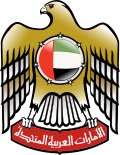Defence
A 7 km long defensive structure, Wadi Sur stretches from the site of Shimal Fort (known locally as Sheba's Palace) in a straight line to the coast. The wall has been estimated to originally stand at a height of five metres with a ditch, stone-lined mudbrick wall and rampart, and to have been two metres thick. [2] Some 45 towers [3] are constructed along the entire length of the wall at 150 metre intervals with the sole exception of one length of wall, since destroyed by water erosion in a wadi bed, which has an irregular 'gap' of 60 metres. It has been postulated this would originally have been an entrance, with the dual purpose of admitting visitors and also allowing the wadi waters to pass through at times of spate. [4] .
Creating a defensive barrier between the sea by the modern Ras Al Khaimah suburb of Al Uraibi and the Hajar Mountains, the wall likely protected both the ports, oasis settlements and agricultural hinterland of Julfar and its successor settlement Ras Al Khaimah. [3] It consisted of a 3.5 metre wide and 2.5 metre deep ditch, with a rampart and wall forming the 5 metre high defensive structure. [2] The date of its construction is uncertain and has been variously estimated as being concurrent with the construction of Shimal Fort in the 11th century and as being constructed during the 'Hormuzi boom' at Julfar in the 14th centuries. [5] The wide spread of potential construction dates of both the Wadi Sur and Sheba's Palace has been referred to as an "uncomfortably wide degree of interpretative latitude" by academics. [6]
Shimal Fort appears to have been abandoned in the 16th century, possibly after direct rule from Hormuz was imposed on Julfar in 1520 [7] following an attempt at rebellion against Hormuz by Lar and Julfar in 1499 and 1508. [5]
This page is based on this
Wikipedia article Text is available under the
CC BY-SA 4.0 license; additional terms may apply.
Images, videos and audio are available under their respective licenses.

